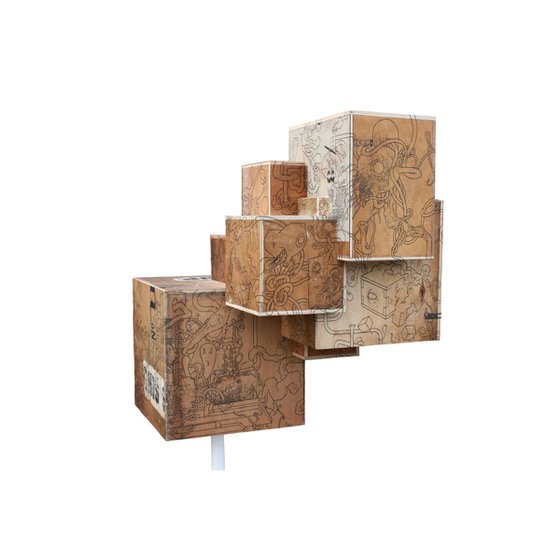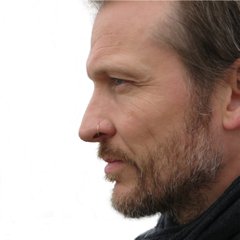- By medium
- By subject
- By budget
- Sales
- Gift cards
- Discover all art
- Artists
- Editors’ picks
- Ideas
Original artwork description:
A plywood sculpture (made from sections of antique packing crates from the Victoria and Albert Museum, London), mounted upon a stand that consists of a metal pole and metal base plate, with an optional extra support of a larger plywood base board (and fixings) in case the sculpture is to be exhibited in a busy gallery environment where there is a danger of visitors bumping into it. The sculpture and support travels in three separate, custom-made, packing crates with quick-release fixings.
This sculpture evolved from my interest in applying organic-looking structural developments (that have gone awry) to very geometric forms. In this case I have taken as my inspiration the mechanism of a cancer cell, where growth has gone unchecked and produced an unstable-looking, asymmetrical form. The 'tattooed' element of the piece harks back to growing up with a tattooist father but the style of the drawings relate more to my early career as a technical illustrator. As for the subject of the drawings - the starting point was based upon found materials that I had collected for use in future sculptures, but which I chose to morph together or exaggerate beyond recognition.
As with many of my artistic projects, I underestimated just how long the drawing side of the work would take. There are several reasons for this. One being the fact that all the drawings are quite intricate and time consuming to develop from scratch, especially since I planned for all the elements to have their own unique qualities whilst still looking like they could coexist in the same universe. Couple this with the fact that, put together, all the forty four separate planes of the sculpture's components add up to a much larger surface area than one might expect, I now clearly see why the piece took so long to complete.
Another reason that the drawing process took so long is that each sketch had to be done four separate times – firstly worked out as a pencil sketch in one of my sketchbooks, then traced in ink onto tracing paper, thirdly, transferred onto the sculpture using carbon paper and drawing over the image on the tracing paper, and finally there would be the time consuming task of inking in the carbon ghost image on the sculpture's wooden surface.
Initially, I started off the drawing process by rendering elements of the miscellaneous found objects, and morphing them together but once I got into the flow of it, and started to really develop a feel for the world that my drawings evolved from, I mostly abandoned the use of existing source materials, and opted for the freedom of simply making it all up.
As I mentioned earlier, the sculpture is made up of cut-up pieces of antique packing crates, sourced from the Victoria and Albert Museum - and you can even see sections of old labels, stencilled numbers, and part of the lettering of “V. & A. M.”, branded into the wood in a charming early twentieth century typography.
There are lots of drawn elements of the piece that I've especially enjoyed creating, and one of them is the underside of the base section of the sculpture (see secondary photo of pre-assembled section for closer deatils), and therefore probably the part that is least likely to be seen. As the circular hole in the centre is for the insertion of the pole that makes up part of the work's metal stand, I thought that I'd make it a feature of the overall design, and incorporated a sphincter element to the drawing. The sigils which appear within to outer ring reference occult interests as well as being a tribute to the flamboyantly entertaining comic book writer, Grant Morrison.
Materials used:
ink drawings on antique plywood structure, on metal stand
Featured by our Editors:
Tattooed Tumour Box (2014) Wood sculpture
by Wayne Chisnall
£18,000 Sold
- Wood sculpture on Panel / Board / MDF
- One of a kind artwork
- Size: 65 x 145 x 65cm
- Ready to hang
- Signed on the front
- Style: Geometric
- Subject: Abstract and non-figurative
Do you like this artwork?
This artwork has sold, but the artist is accepting commission requests. Commissioning an artwork is easy and you get a perfectly personalised piece.
Loading
Original artwork description
A plywood sculpture (made from sections of antique packing crates from the Victoria and Albert Museum, London), mounted upon a stand that consists of a metal pole and metal base plate, with an optional extra support of a larger plywood base board (and fixings) in case the sculpture is to be exhibited in a busy gallery environment where there is a danger of visitors bumping into it. The sculpture and support travels in three separate, custom-made, packing crates with quick-release fixings.
This sculpture evolved from my interest in applying organic-looking structural developments (that have gone awry) to very geometric forms. In this case I have taken as my inspiration the mechanism of a cancer cell, where growth has gone unchecked and produced an unstable-looking, asymmetrical form. The 'tattooed' element of the piece harks back to growing up with a tattooist father but the style of the drawings relate more to my early career as a technical illustrator. As for the subject of the drawings - the starting point was based upon found materials that I had collected for use in future sculptures, but which I chose to morph together or exaggerate beyond recognition.
As with many of my artistic projects, I underestimated just how long the drawing side of the work would take. There are several reasons for this. One being the fact that all the drawings are quite intricate and time consuming to develop from scratch, especially since I planned for all the elements to have their own unique qualities whilst still looking like they could coexist in the same universe. Couple this with the fact that, put together, all the forty four separate planes of the sculpture's components add up to a much larger surface area than one might expect, I now clearly see why the piece took so long to complete.
Another reason that the drawing process took so long is that each sketch had to be done four separate times – firstly worked out as a pencil sketch in one of my sketchbooks, then traced in ink onto tracing paper, thirdly, transferred onto the sculpture using carbon paper and drawing over the image on the tracing paper, and finally there would be the time consuming task of inking in the carbon ghost image on the sculpture's wooden surface.
Initially, I started off the drawing process by rendering elements of the miscellaneous found objects, and morphing them together but once I got into the flow of it, and started to really develop a feel for the world that my drawings evolved from, I mostly abandoned the use of existing source materials, and opted for the freedom of simply making it all up.
As I mentioned earlier, the sculpture is made up of cut-up pieces of antique packing crates, sourced from the Victoria and Albert Museum - and you can even see sections of old labels, stencilled numbers, and part of the lettering of “V. & A. M.”, branded into the wood in a charming early twentieth century typography.
There are lots of drawn elements of the piece that I've especially enjoyed creating, and one of them is the underside of the base section of the sculpture (see secondary photo of pre-assembled section for closer deatils), and therefore probably the part that is least likely to be seen. As the circular hole in the centre is for the insertion of the pole that makes up part of the work's metal stand, I thought that I'd make it a feature of the overall design, and incorporated a sphincter element to the drawing. The sigils which appear within to outer ring reference occult interests as well as being a tribute to the flamboyantly entertaining comic book writer, Grant Morrison.
Materials used:
ink drawings on antique plywood structure, on metal stand
Featured by our Editors:
14 day money back guaranteeLearn more



